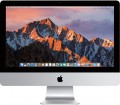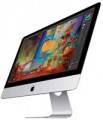Brightness
The maximum brightness provided by the monoblock screen (see "Type").
The more intense the ambient light, the higher the screen brightness should be for normal visibility. The most "dim" screens in monoblocks are capable of delivering up to 200 cd / m2 — this is more than enough to work under ordinary artificial lighting, but under sunlight it will take at least 300 cd / m2. At the same time, modern monoblocks can also have a larger margin of brightness — in some models up to 500 cd / m2. This expands the possibilities for customizing the screen for different situations and user preferences. In addition, high brightness has a positive effect on image quality and colour saturation, in light of which it is often a sign of a fairly advanced screen.
Type
The general type (specialization) of the processor installed in the PC.
—
Desktop. Processors originally designed for full-sized desktop computers. The specific characteristics of such CPUs can vary quite widely; however, in general, they have higher processing power than mobile chips, as well as a wider range of additional features and special solutions to improve efficiency. And with the same actual performance, desktop solutions are much cheaper than mobile ones. The downside of these advantages is the relatively high energy consumption and heat dissipation. However, for full-sized PCs, these shortcomings are not critical, so almost all traditional desktop computers, as well as most all-in-ones (see "Type") are equipped with this particular type of processor; and for powerful gaming models, a desktop CPU is mandatory by definition. On the other hand, this category also includes rather economical and "cold" low-power chips, which are suitable for compact computers that do not require high performance, such as nettops and thin clients.
—
Mobile. This term in this case refers to processors originally designed for laptops. Most of these CPUs use the same basic architecture as desktop models — x86. Their main differences are: on the one hand, reduced energy consumption, reduced clock frequencies and low heat generation, on the other hand, less computing power in general. However the actu
...al characteristics of such processors may vary from model to model, some laptop solutions are not inferior to fairly advanced desktop ones; however, with similar capabilities, a laptop processor will cost significantly more. Thus, this type of CPU is mainly used in nettops and individual models of monoblocks (see "Type"), where it is difficult to use powerful cooling systems.
A rarer variety of mobile processors used in modern PCs are chips based on the basic ARM architecture. Such processors have even lower heat dissipation and power, and are also often implemented in the System-On-Chip format, when the CPU itself, RAM, wired and wireless connection controllers, and other components are combined in one chip. ARM solutions can be found in Android touchscreen all-in-ones (which are effectively "desktop tablets"), as well as in individual thin clients.Model
The specific model of the processor installed in the PC, or rather, its index within its series (see "Processor"). The full model name consists of the series name and this index — for example, Intel Core i3 3220; knowing this name, you can find detailed information about the processor (characteristics, reviews, etc.) and determine how suitable it is for your purposes.
Threads
The number of threads supported by the bundled PC processor.
A thread in this case is a sequence of instructions executed by the kernel. Initially, each individual core is able to work with only one such sequence. However, among modern CPUs, more and more often there are models in which the number of threads is twice the number of cores. This means that the processor uses multi-threading technology, and each core works with two instruction sequences: when pauses occur in one thread, the core switches to another, and vice versa. This allows you to significantly increase performance without increasing the clock frequency and heat dissipation, however, such CPUs are also more expensive than single-threaded counterparts.
Speed
Clock speed of the CPU installed in the PC.
In theory, higher clock speeds have a positive effect on performance because they allow the CPU to perform more operations per unit of time. However, this indicator is rather weakly related to real productivity. The fact is that the actual capabilities of the CPU strongly depend on a number of other factors - the overall architecture, cache size, number of cores, support for special instructions, etc. As a result, you can compare by this indicator only chips from the same or similar series (see “CPU”), and ideally, also from the same generation. And that's pretty approximate.
TurboBoost / TurboCore
Processor clock speed when running in TurboBoost or TurboCore mode.
Turbo Boost technology is used in Intel processors, Turbo Core — AMD. The essence of this technology is the same both there and there: if some of the cores work under high load, and some are idle, then some tasks are transferred from more loaded cores to less loaded ones, which improves performance. This usually increases the clock frequency of the processor; this value is indicated in this paragraph. See above for more information on clock speed in general.
Passmark CPU Mark
The result shown by the PC processor in the test (benchmark) Passmark CPU Mark.
Passmark CPU Mark is a comprehensive test that allows you to evaluate CPU performance in various modes and with a different number of processed threads. The results are displayed in points; the more points, the higher the overall performance of the processor. For comparison: as of 2020, in low-cost solutions, the results are measured in hundreds of points, in mid-range models they range from 800 – 900 to more than 6,000 points, and individual top-end chips are capable of showing 40,000 points or more.
Geekbench 4
The result shown by the PC processor in the test (benchmark) Geekbench 4.
Geekbench 4 is a comprehensive cross-platform test that allows, among other things, to determine the efficiency of the processor in various modes. At the same time, according to the developers, the verification modes are as close as possible to various real tasks that the processor has to solve. The result is indicated in points: the more points — the more powerful the CPU, while the difference in numbers corresponds to the actual difference in performance ("twice the result — twice the power").
Note that the benchmark in Geekbench 4 is the Intel Core i7-6600U processor with a clock frequency of 2.6 GHz. Its power is estimated at 4000 points, and the performance of other tested CPUs is already compared with it.
Cinebench R15
The result shown by the PC processor in the test (benchmark) Cinebench R15.
Cinebench is a test designed to test the capabilities of the processor and graphics card. The creator of this benchmark, Maxon, is also known as the developer of the Cinema 4D 3D editor; this determined the features of testing. So, in addition to purely mathematical tasks, when using Cinebench R15, the processor is loaded with processing high-quality three-dimensional graphics. Another interesting feature is the extensive support for multithreading — the test allows you to fully check the power of chips that process up to 256 threads at a time.
Traditionally, for CPU benchmarks, the test results are indicated in points (more precisely, points — PTS). The more points scored by the CPU, the higher its performance.

